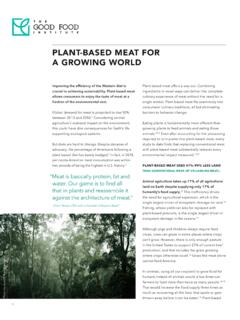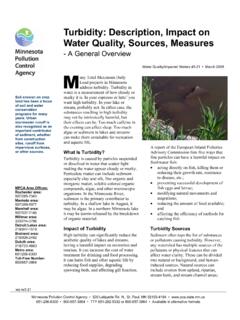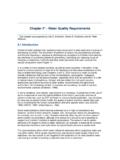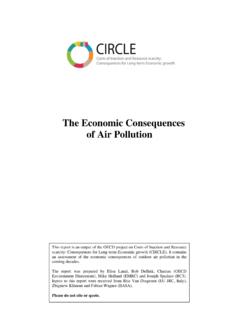Transcription of Coping with water scarcity in agriculture
1 Coping with water scarcity in agriculture a global framework for action in a changing climateWhy a global framework for action on water scarcity in agriculture is neededThe world is thirsty, because it is hungryWater is essential for agricultural1 production and food security. It is the lifeblood of ecosystems, including forests, lakes and wetlands, on which the food and nutritional security of present and future generations depends. water of appropriate quality and quantity is essential for drinking and sanitary purposes and for food production (fisheries, crops and livestock), processing and preparation. water is also important for the energy, industry and other economic sectors.
2 water streams and bodies are often key means of transport (including of inputs, food and feed). Overall, water supports economic growth and income generation and, therefore, economic access to , significant parts of the world are struggling with water scarcity (Figure 1). From California to China s eastern provinces, from Jordan to the southern tip of Africa, an estimated two-thirds of the global population over 4 billion people live with severe water shortages for at least one month each year. Although, overall, there will be sufficient water in a changing climate to satisfy the demand for food at the global level, a growing number of regions will face increasing water the global population heads for more than 9 billion people by 2050, demand for food is expected to surge by more than 50 percent.
3 The world is rapidly becoming wealthier and more urbanized, and 1 agriculture comprises crops, livestock, fisheries, aquaculture and : FAO/Marco Longari, FAO/Giulio Napolitano (2 & 4), FAO/Sergey Kozmin2food preferences are changing to reflect this: the consumption of staple carbohydrates is on a declining trend while demand for high-value products such as milk, meat, fruits and vegetables which, in many parts of the world, have much higher water footprints is increasing. At the same time, competition for increasingly scarce land, water and energy resources is intensifying, further aggravated by the existential threat of climate change..and a declining resource is both a cause and a victim of water scarcity .
4 The excessive use and degradation of water resources is threatening the sustainability of livelihoods dependent on water and agriculture . Inefficient and uncoordinated water use depletes aquifers, reduces river flows and degrades wildlife habitats, and it has caused salinization on 20 percent of the global irrigated land area. The inappropriate use of fertilizers and pesticides translate into water pollution , affecting rivers, lakes and coastal areas. The bulk of production in capture fisheries comes from coastal waters, where both the productivity and quality of fish stocks are severely affected by pollution , a great part of which comes from agricultural crop production, aquaculture and the required levels of production from an already seriously depleted natural resource base requires profound changes in our food and agriculture systems, ensuring global food security, provid-ing economic and social opportunities, and protecting the ecosystem services on which agriculture water becomes scarcer, it is fundamentally important to tackle the issue head-on.
5 The adoption of Sustainable Development Goal (SDG) 6 creates an opportunity to system-atically engage with key water -scarce countries and to inform and orient national policies towards effective, sustainable models of water management and governance. Target of SDG 6 increasing water -use efficiency across all sectors and ensuring sustainable withdrawals and supply of freshwater to address water scarcity , and substantially reducing the number of people suffering from water scarcity is especially rele-vant in a changing climateClimate change will have significant impacts on agriculture by increasing water demand, limiting crop productivity and reducing water availability in areas where irrigation is most needed or has a compar-ative advantage.
6 Projections show a general reduction in precipitation in semiarid areas, an increase in precipitation in temperate zones, higher variability in rainfall distribution, an increase in the frequency of extreme events, and an increase in temperature. A severe reduction in river runoff and aquifer recharge is expected in the Mediterranean Basin and in semiarid areas in southern Africa, Australia and the Americas, affecting the availability of water for all river base flows, increased flooding and rising sea levels are predicted to affect highly productive irrigated systems dependent on glacier melt ( in the Punjab region, and Colorado) and lowland deltas ( those of the Indus, Nile and Brahmaputra Ganges Meghna).
7 In the semiarid " water is a precious resource, crucial to realizing the Sustainable Development Goals, which at their heart aim to eradicate poverty UN Secretary-General Ban Ki-moonPhotos: FAO/Ado Youssouf, FAO/Asim Hafeez, FAO/Sarah Elliott 3 FIGURE 1. GLOBAL MAP OF PHYSICAL water scarcity BY MAJOR RIVER BASIN tropics, where droughts and floods are expected to increase in frequency and severity, climate change is likely to especially affect the rural poor by reducing crop and livestock political will to actAddressing water scarcity in the agriculture sector directly contributes to the achievement of the 2030 Agenda for Sustainable Development and its SDGs (see box), and the Paris Agreement of the United Nations Framework Convention on Climate Change (UNFCCC).
8 The Paris AgreementThe Paris Agreement an outcome of the 21st Conference of the Parties to the United Nations Framework Convention on Climate Change provides opportuni-ties for adaptation and mitigation actions in agriculture . Among other things, it establishes the global goal of enhancing adaptive capacity, strengthening resilience and reducing vulnerability to climate change, with a view to contributing to sustainable development and ensuring an adequate adaptation response2. 2 Intergovernmental Panel on Climate Change. 2014. Summary for policymakers. In: Climate change 2014: impacts, adaptation, and vulnerability." Freshwater-related risks of climate change increase significantly with increasing greenhouse gas concentrations (robust evidence, high agreement).
9 The fraction of global population experiencing water scarcity and the fraction affected by major river floods increase with the level of warming in the 21st century IPCC, 20142 Photos: FAO/Olivier Asselin, FAO/Giulio Napolitano (2 &3)Source: Hoogeveen et al, 20144 The Paris Agreement recognizes the fundamental goal of ensuring food security and ending hunger, as well as the vulnerability of food production systems to climate change. Adapting agriculture to climate change is closely linked to water management: adaptation measures that build on existing good land, water and agricultural management practices enhance both resilience and water security. Innovative and sustainable water -management technologies derived from applied research, combined with appropriate policies and strategies, will help in the mitigation of, and adaptation to, climate for immediate and concerted effort: the Global Framework for Action to Cope with water scarcity in agriculture in the Context of Climate ChangeWater scarcity presents an immediate threat to people, the planet and the path to inclusive and sustainable development.
10 As the largest water user globally and a major source of water pollution , agriculture will play a key role in tackling the looming water crises. What can agriculture do to address water scarcity in the context of climate change, while ensuring food and nutrition security? What responses can the agriculture and food sectors offer to alleviate the impacts and reduce the risks of water scarcity ? To respond to these challenges in a coordinated and effective manner, FAO and a broad range of part-ners has developed the Global Framework for Action to Cope with water scarcity in agriculture in the Context of Climate Change (abbreviated below to the Global Framework for Action and the Global Framework ).


















